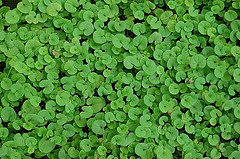For the first time in my life, I have a house with a yard that I take care of, or, more importantly that I care about. Something about a $700K house.
One of the factors in our selection of this house was a safe, sane yard for our dogs, at the time an epileptic greyhound, and his older brother, a well aged greyhound. The small back yard had a pretty decent piece of grass, my lawn, and I have put effort into keeping it nice.
The first challenge was the west end of the yard, it is perpetually in shade, and when it rains (which happened a lot the last year), it never dries out, grass didn’t get enough sunlight to grow, and it was almost a permanent bog.
We fixed that with some decomposed granite, creating what we call the “landing” zone, that has then added bonus of being the preferred pooping ground of our dogs. This last winter, a very wet winter by Bay Area standards, the landing zone remained navigable instead of being the muddy mess it used to be.
The lawn is a smallish patch, probably 40’ wide by 12’ deep, so 480 sqft or so. At one time, it clearly had been sodded (roll type sod put down) to start with, as digging yields the tell-tale green mesh. But that was long before we bought the house.
Now, when you look closely at the grass, there are at least 4 different types of grass. The most common is a Fescue style. Hearty, fast growing, and it is in the repair mix that I buy (more on this later), it dominates the lawn. Not only that, it is probably what was the original sod laid down.
However, that isn’t the whole story. There is plenty of other types of grass in the mix. The next up on the list is bermuda grass. This doesn’t grow as tall as the fescue, but it does have a dense matt that is distinctive. Yet, it is definitely a clash with the Fescue.
Third up on the list is the DIchondra patches. Unlike the fescue and the Bermuda grasses, this is a broadleaf, and it is quite different, and distinctive. However, it does clash with the rest of the yard. One must wonder why the prior owners grabbed some dichondra seed (it is quite different that traditional grass seed) and tossed it around the yard.
Last, and most sucky is crab grass. More of a weed, it is there, and it is a royal pain in the arse to deal with. Alas, I manually extract it, and avoid chemical treatments.
The Grass-Killer
While I do work to maintain my yard for the benefit of my dog, I must acknowledge that he has a new nickname – grasskiller. I do love him, but as he has aged, and he has become less mobile, he has taken to urination in single spots and in quantities that inject enough excess nitrogen that the lawn has no chance.
This year, I have been using Scott’s Dog Repair mix pretty much continuously, but it is a losing battle. Le sigh.
Summary
For the longest time I really looked down on people who obsessed about their lawns. Alas, I have joined their ranks.
Perhaps one day I will re-do the grass in the yard, picking something more amenable to dog abuse, a perennial ryegrass perhaps. But until I get that burst of energy, I will keep nursing my melting-pot lawn.
